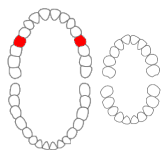Maxillary second premolar
== Maxillary Second Premolar ==
The maxillary second premolar is one of the permanent teeth located in the upper jaw, specifically in the maxilla. It is situated distal to the maxillary first premolar and mesial to the maxillary first molar. This tooth plays a crucial role in the chewing process and in maintaining the occlusal balance of the dental arches.
Anatomy[edit | edit source]
The maxillary second premolar typically has two cusps: a buccal cusp and a lingual cusp. The buccal cusp is usually slightly larger than the lingual cusp. The tooth has a single root, which is generally longer and more slender compared to the root of the maxillary first premolar. The root canal system of the maxillary second premolar can vary, but it often contains one or two canals.
Function[edit | edit source]
The primary function of the maxillary second premolar is to assist in the chewing and grinding of food. It also helps maintain the vertical dimension of the face and supports the temporomandibular joint by distributing the forces of chewing.
Development[edit | edit source]
The development of the maxillary second premolar begins with the formation of the tooth bud during the early stages of childhood. The tooth typically erupts into the oral cavity between the ages of 10 and 12 years. The root formation is usually completed by the age of 13 to 15 years.
Clinical Significance[edit | edit source]
The maxillary second premolar is often involved in various dental procedures, including restorative dentistry, endodontics, and orthodontics. It is a common site for dental caries and may require dental fillings or root canal therapy if the pulp becomes infected. In orthodontic treatment, the maxillary second premolar may be extracted to create space for the alignment of other teeth.
Variations[edit | edit source]
There can be variations in the anatomy of the maxillary second premolar, including differences in the number of cusps, root morphology, and the presence of additional root canals. These variations can affect the approach to dental treatments and procedures.
See Also[edit | edit source]
- Maxillary first premolar
- Maxillary first molar
- Mandibular second premolar
- Permanent teeth
- Mastication
- Occlusion (dentistry)
- Temporomandibular joint
- Restorative dentistry
- Endodontics
- Orthodontics
- Dental caries
- Root canal therapy
Search WikiMD
Ad.Tired of being Overweight? Try W8MD's physician weight loss program.
Semaglutide (Ozempic / Wegovy and Tirzepatide (Mounjaro / Zepbound) available.
Advertise on WikiMD
|
WikiMD's Wellness Encyclopedia |
| Let Food Be Thy Medicine Medicine Thy Food - Hippocrates |
Translate this page: - East Asian
中文,
日本,
한국어,
South Asian
हिन्दी,
தமிழ்,
తెలుగు,
Urdu,
ಕನ್ನಡ,
Southeast Asian
Indonesian,
Vietnamese,
Thai,
မြန်မာဘာသာ,
বাংলা
European
español,
Deutsch,
français,
Greek,
português do Brasil,
polski,
română,
русский,
Nederlands,
norsk,
svenska,
suomi,
Italian
Middle Eastern & African
عربى,
Turkish,
Persian,
Hebrew,
Afrikaans,
isiZulu,
Kiswahili,
Other
Bulgarian,
Hungarian,
Czech,
Swedish,
മലയാളം,
मराठी,
ਪੰਜਾਬੀ,
ગુજરાતી,
Portuguese,
Ukrainian
Medical Disclaimer: WikiMD is not a substitute for professional medical advice. The information on WikiMD is provided as an information resource only, may be incorrect, outdated or misleading, and is not to be used or relied on for any diagnostic or treatment purposes. Please consult your health care provider before making any healthcare decisions or for guidance about a specific medical condition. WikiMD expressly disclaims responsibility, and shall have no liability, for any damages, loss, injury, or liability whatsoever suffered as a result of your reliance on the information contained in this site. By visiting this site you agree to the foregoing terms and conditions, which may from time to time be changed or supplemented by WikiMD. If you do not agree to the foregoing terms and conditions, you should not enter or use this site. See full disclaimer.
Credits:Most images are courtesy of Wikimedia commons, and templates, categories Wikipedia, licensed under CC BY SA or similar.
Contributors: Prab R. Tumpati, MD

